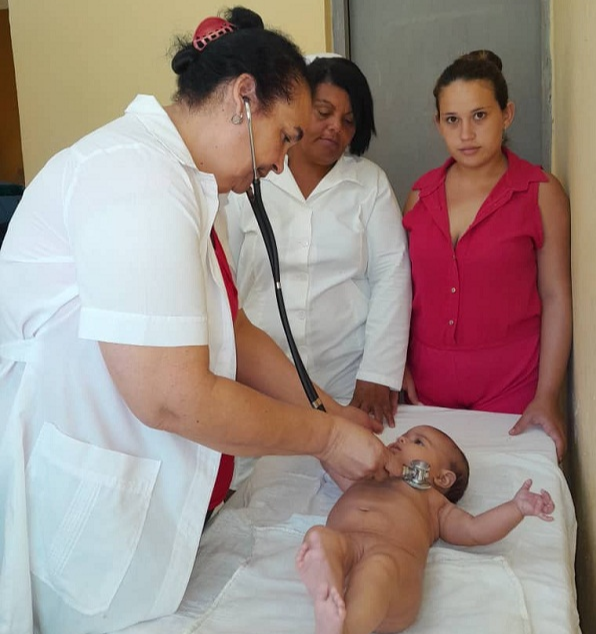
Sancti Spíritus exhibits stable results during the last five years in the Program
of Maternal and Child Care. Photo: Arelys García Acosta
By Arelys García Acosta
Sancti Spíritus, July 21 (RHC)-- He has been seen walking up to eight kilometers along lonely paths, full of mountains from side to side; and when he has arrived, the sweat runs in trickles down his body and the white coat no longer looks white from sticking so much to his wet body and to the backpack on his back.
This is the daily itinerary of the young doctor Yagensi Yoján Betancourt Castro in his visits to pregnant women residing in intricate areas of communities 21, 22 and 23, of the Pitajones Popular Council, of the municipality of Trinidad.
“I already know every nook and cranny of these mountains, and to go visit a patient I might as well ride on a bread wheel as in a cart or on the back of a horse.”
FOR THOSE LITTLE THINGS...
For those small things that make the big things possible, and that have their protagonists in Primary and Secondary Health Care, the statistics are explicit.
So far this year, the Sancti Spiritus Turquino Plan does not report maternal deaths or deaths of children under one year of age, and the province, in general, exhibits an infant mortality rate of 3.2 per 1,000 live births, the lowest in Cuba. till the date.
These are first-world figures, which place Sancti Spíritus among the territories with the most stable results over the last five years in this parameter of the Maternal and Child Care Program (PAMI).
This behavior had weight and measure in the decision of the Political Bureau of the Communist Party of Cuba to grant the territory the headquarters of the national event for the 71st anniversary of the assault on the Moncada and Carlos Manuel de Céspedes barracks, in the east of the country.
In the opinion of Dr. Francisco Fernández Quintero, provincial director of Health, these results are fundamentally based on Primary Health Care, in particular, on the performance of the family doctor's and nurse's offices.
Furthermore, the intersectoral work shown by the territory that has maternity homes in the eight municipalities stands out, from where risks in prenatal care are prevented, Fernández Quintero stressed.
"However, even today the percentage of home occupancy is not what is desired and, therefore, it is necessary to take advantage of the potential of these institutions and strengthen actions so that more pregnant women with income requirements are cared for there," he finally indicated.
Although the infant mortality rate is lower than even that of developed countries, the province focuses its attention on some deficiencies related, for example, to the monitoring of the risk of prematurity protocol.
According to Dr. Francisco García González, head of PAMI in the Provincial Health Directorate, “the purpose is to prevent children from being born prematurely or from having delayed intrauterine growth.”
In this sense, the official warned about the high rate of teenage pregnancy in Sancti Spíritus, today with 17.2, the worst result in Cuba.
The territory has 193 pregnant women of these ages, with the highest incidence in the municipalities of Taguasco, Jatibonico, Sancti Spíritus and La Sierpe, which shows that teenage pregnancies represent a serious problem for morbidity in the province.
This is recognized by Dr. Manuel López Fuentes, a first-degree specialist in Neonatology and head of the Continuous Morbidity Committee in the Neonatal Intensive Care Unit of the 'Camilo Cienfuegos' Provincial General Hospital, who masters eloquent statistics.
Of the more than 400 neonates admitted last year to the Intensive Care Units with a history of Retarded Intrauterine Growth (CIUR)—preterm births and low birth weight (less than 2,500 grams)—the highest percentage of them mothers between 13 and 15 years of age contributed.
These and other statistics, such as the low birth weight index—currently rising to 6.5—reveal that PAMI cannot be a solo battle of doctors and nurses.
With such certainty, the Provincial Health Directorate has created multidisciplinary groups to carry out interventions for infants and pregnant women in each of the municipalities.
“The intention is to promote intersectoral work based on exchanges with colleagues from the Popular Council and the community to seek joint solutions.
“In fact, a program was made with 27 organizations and 165 actions to adapt them to the characteristics of each area, so that the problems are less and less and do not negatively impact the PAMI,” said Dr. Francisco García González.

